Fraud detection is a critical priority for businesses across different industries. As Statista reports, the fraud detection and prevention market soared from $19.5 billion in 2017 to $63 billion by 2023.
It becomes apparent that multiple companies strive to have detection solutions tailored to combat fraudulent activities such as insurance scams, identity theft, and money laundering as their reputation and business longevity depend on it. And thanks to the advent of machine learning, fraud detection and prevention has gained significant potency. Let’s explore the advantages of fraud detection using machine learning and delve into the commonly used models that safeguard diverse industries and their clientele.
Machine Learning Models for Fraud Detection
Machine learning relies on data analysis models. These models take features as input and use a set of parameters or weights to process the features and generate an output, which could be a prediction or classification.
Each machine learning model has its own architecture and learning algorithms to identify patterns from the features. Let’s examine them more closely based on their learning approaches.
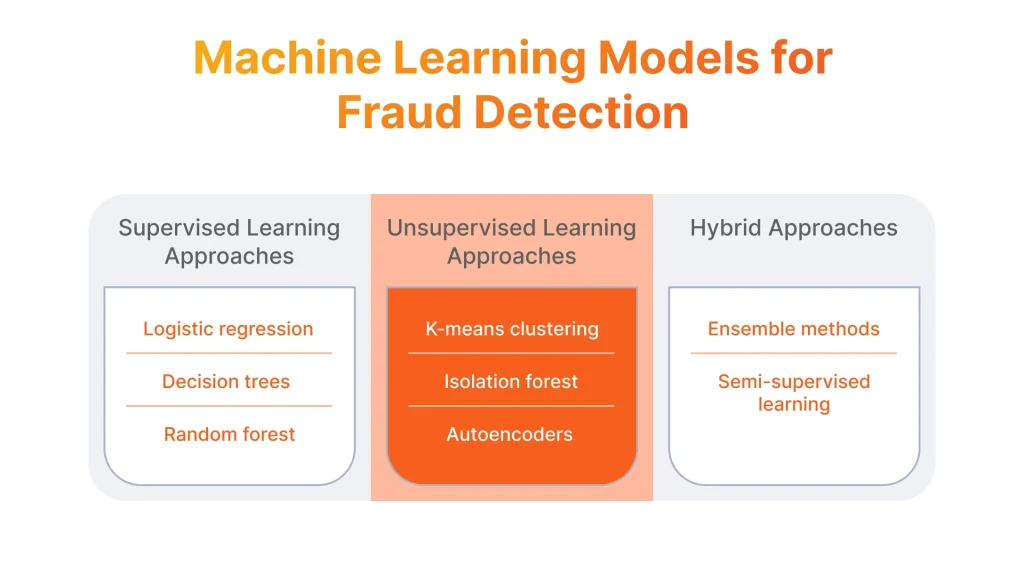
Supervised Learning Approaches
- Logistic regression models the probability that a given instance belongs to a particular class (e.g., fraud or non-fraud) based on its features. It uses the logistic function to transform the output of a linear equation into a probability value between 0 and 1. Except for fraud detection, these models are part of machine learning demand forecasting in retail and AI-powered medical diagnosis predictions in healthcare.
- Decision trees recursively partition the feature space based on feature values to make predictions. At each node of the tree, a decision is made based on the value of a feature, leading to a split in the data. The process continues until a stopping criterion is met, typically when further splits do not improve the purity of the subsets. Decision trees are part of efforts with machine learning for finance, healthcare, and marketing, as well as to assess credit risks, come up with disease diagnosis, and predict customer behavior.
- Random forest builds multiple decision trees on bootstrapped samples of the data and combines their predictions to make a final prediction. Each tree in this machine learning model is trained on a random subset of features, reducing the correlation between trees and improving the overall performance and robustness of the model. Besides fraud prevention, random forest is used in spam filtering, and medical diagnosis.
Unsupervised Learning Approaches
- Isolation forest isolates anomalies by randomly selecting a feature and partitioning the data into two subsets. This process is repeated recursively until anomalies are isolated in small partitions. Anomalies, like fraudulent transactions, are detected as instances that require fewer partitions to separate them from the rest of the data. Isolation forest is utilized for credit card fraud detection using machine learning, network intrusion detection, etc.
- Autoencoders consist of an encoder network that compresses the input data into a lower-dimensional representation (encoding) and a decoder network that reconstructs the original input data from the encoding. The model is trained to minimize the reconstruction error, forcing it to learn meaningful features from the data.
- K-means clustering partitions the dataset into k clusters by iteratively assigning data points to the nearest cluster centroid and updating the centroids until convergence. The number of clusters (k) is pre-defined by the user. K-means clustering is commonly used for customer segmentation, image compression, recommendation systems, and anomaly detection.
Looking to grasp the intricacies of anomaly detection with machine learning?
Delve further into the subject with our article!
Hybrid Approaches
- Ensemble methods create a diverse set of base models, either by training different models on different subsets of the data (bagging) or by sequentially training models to correct the errors of previous ones (boosting). The predictions of these base models are then aggregated to produce a final prediction. Ensemble methods are widely used for classification, regression, and anomaly detection. One of its uses can be found in AI/ML in manufacturing for supply chain optimization and quality control.
- Semi-supervised learning techniques typically combine supervised learning with unsupervised learning. For example, self-training iteratively trains a model on labeled data and uses it to label unlabeled data, which is then incorporated into the training set for the next iteration. Semi-supervised learning is used for natural language processing not only in fraud prevention but also in AI support and AI in the food industry for packaging and labeling products.

Serhii Leleko
ML&AI Engineer at SPD Technology
“Each approach—supervised learning, unsupervised learning, and hybrid methods—offers unique strengths and applications in training ML models. Supervised learning provides clear guidance with labeled data, allowing for precise predictions and classification tasks. Unsupervised learning, on the other hand, enables the discovery of hidden patterns and structures within unlabeled data, offering insights and clustering capabilities. Hybrid approaches, combining elements of both, harness the power of labeled and unlabeled data, offering versatility and adaptability across a wide range of tasks. Understanding the nuances of each method is essential for designing an effective machine learning system tailored to specific problem domains.”
How Machine Learning Models Work for Detecting Different Types of Fraud
Leveraging the power of machine learning, businesses can fortify their defenses against different kinds of fraudulent activities. From payment fraud to identity theft, each malicious scheme demands specific approaches for effective detection. Below we delve into how ML models serve as solid tools to fight fraud.
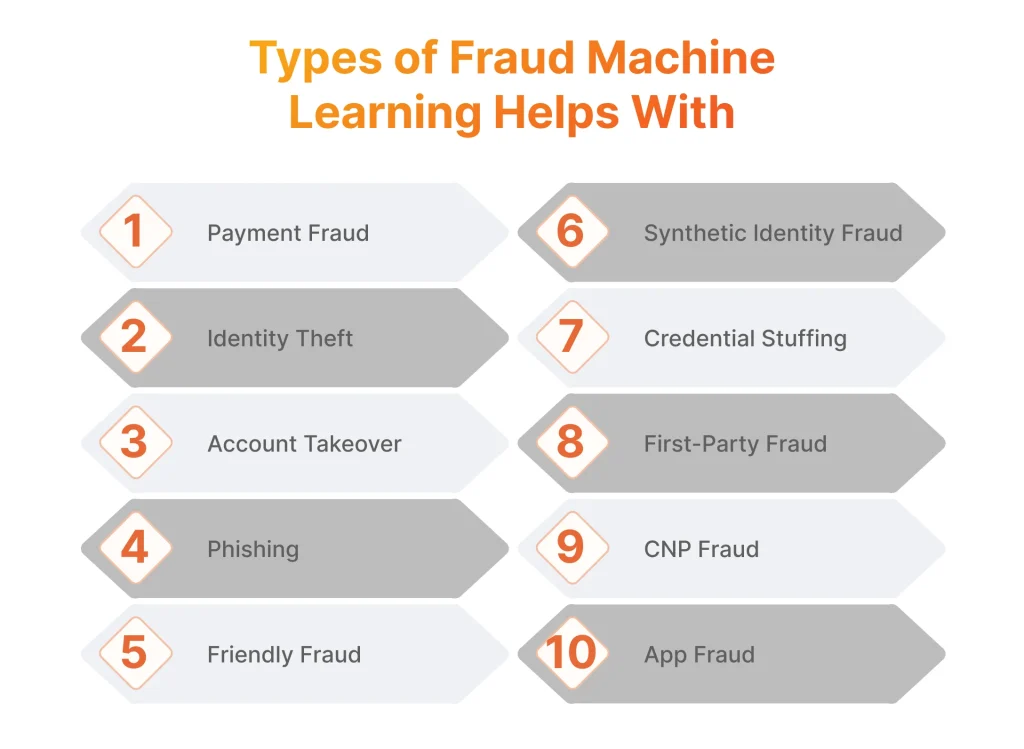
Payment Fraud
When it comes to detecting fraudulent transactions involving stolen credit/debit card information or unauthorized payments, logistic regression emerges as one of the most effective ML models. It is particularly well-suited for binary classification tasks, making it an ideal choice for detecting credit card fraud. It works by analyzing transaction data and identifying patterns that are indicative of fraudulent behavior.
Through analyzing these patterns, logistic regression can accurately distinguish between fraudulent and legitimate transactions, empowering financial institutions to promptly mitigate financial losses and safeguard the interests of customers.
Identity Theft
As reported by the Bureau of Justice Statistics, in 2021, around 59% of identity-theft victims suffered financial losses amounting to $1 or more, totaling $16.4 billion in the US. To combat this pressing issue, decision trees prove effective, addressing situations where unauthorized sensitive data (e.g., social security numbers, driver’s licenses) is exploited to open accounts or make purchases.
Decision trees excel at capturing complex decision boundaries and identifying non-linear fraud patterns inherent in identity theft schemes. In this case, machine learning for fraud detection works by analyzing diverse features associated with identity-related transactions, such as account creation details, transaction history, and user behavior. Decision trees can effectively discern suspicious behavior indicative of identity theft, such as unusual patterns in account activity or inconsistencies in personal information.
Account Takeover
Account takeovers mean unauthorized access to a user’s online account for the purpose of stealing personal information or engaging in a malicious activity. In addressing this threat, neural networks are the best suited ML model.
Neural networks, being powerful deep learning models, excel at learning complex patterns and relationships in data. They achieve this by analyzing multiple factors such as user behavior data, login activity, and device information. Their ability to detect subtle deviations from normal behavior and distinguish between legitimate and fraudulent activities makes neural networks effective in establishing security against account takeover.
Phishing Scams
Phishing scams involve deceptive emails, messages, or websites designed to trick users into divulging sensitive information such as login credentials and financial details. In addressing this threat, random forests prove to be the most effective machine learning model.
Random forests are robust ensemble learning algorithms capable of handling high-dimensional data and complex decision boundaries. They achieve this by combining multiple decision trees to create a more robust and accurate model. These models are known for their ability to handle both low and high-dimensional data effectively, making them suitable for analyzing the various features present in phishing scams. Their robustness to outliers and noisy data is particularly useful in this context, where the distinction between legitimate and fraudulent communications can be subtle.

Serhii Leleko
ML&AI Engineer at SPD Technology
“When it comes to detecting fraud like phishing scams, random forests can analyze several features, including email content, website characteristics, and user interactions. By examining these features, random forests can effectively classify phishing scams with high accuracy, distinguishing them from legitimate communications. In contrast, gradient boosting is a sequential ensemble method where each tree is trained to correct the errors of the previous trees. While gradient boosting can achieve higher predictive accuracy than random forests, it may not be as suitable for tasks where interpretability is important, such as understanding the features indicative of phishing attempts.”
Summarizing, when it comes to detecting phishing scams and other types of fraud, random forests are a powerful and effective machine learning model. Their ability to analyze multiple features and identify subtle patterns makes them well-suited for distinguishing between legitimate and fraudulent communications.
Friendly Fraud
Detecting friendly fraud, a deceptive practice where legitimate users intentionally dispute or claim refunds for purchases they made, is possible thanks to logistic regression.
This model is well-suited for detecting patterns indicative of friendly fraud due to its ability to handle binary classification tasks efficiently. It analyzes different factors such as historical transaction data and customer behavior to identify suspicious claims. For example, logistic regression can detect sudden spikes in chargeback requests or unusual refund patterns that may signal potential instances of friendly fraud.
Synthetic Identity Fraud
In the context of synthetic identity fraud, a sophisticated scheme involving the creation of fake identities using a blend of genuine and fictitious information, gradient boosting serves as a solid reason for fraud detection software development services.
Gradient boosting combines multiple weak learners, typically decision trees, to enhance predictive performance significantly. Its strength lies in its ability to analyze diverse features associated with synthetic identities and unearth subtle patterns indicative of suspicious behavior. By studying different parameters like account creation details, historical data on transactions, and user behavior, gradient boosting can effectively discern anomalies and inconsistencies that may signal synthetic identity fraud.
Credential Stuffing
Fraud prevention for credential stuffing typically leans on support vector machines (SVMs). In cases where automated fraud attacks leverage stolen login credentials to gain unauthorized access to multiple online accounts, SVMs excel in binary classification tasks, especially those with complex decision boundaries. They effectively analyze diverse features like login activity data, IP addresses, and device information.
First-Party Fraud
To address first-party fraud, where legitimate customers intentionally provide false information or misrepresent their financial status to obtain credit or loans, ML-based fraud detection solutions use ensemble methods.
Ensemble methods are renowned for their ability to combine multiple base models to enhance predictive performance and generalization ability. First-party fraud often involves subtle deviations or inconsistencies in the information provided by applicants, making it challenging to detect using traditional models. However, ensemble methods leverage the collective intelligence of multiple base models to identify patterns and anomalies that may indicate fraud.
Card-Not-Present (CNP) Fraud
CNP fraud involves unauthorized use of credit/debit card information for online or over-the-phone transactions where the physical card is not present. Random forests are used in ML-powered fraud detection systems for addressing this issue.
Random forests manage to handle high-dimensional data and complex decision boundaries, making them well-suited for detecting anomalies in online transaction behavior as they leverage the collective intelligence of multiple decision trees to identify patterns and anomalies that may indicate fraudulent behavior. By aggregating the predictions of individual trees, random forests can achieve superior performance in detecting CNP fraud while minimizing false positives.
Application Fraud
For detecting application fraud, where individuals submit fraudulent applications for financial products or services using false information or stolen identities, ML engineers employ gradient boosting. This model is effective for detecting patterns indicative of application fraud, such as inconsistencies in application details or suspicious behavior during the application process.
Gradient boosting models have the flexibility to adapt to evolving fraud patterns and data distributions, making them well-suited for dynamic environments. Their ability to handle diverse features and learn from both structured and unstructured data sources enables them to provide reliable detection capabilities.
How Machine Learning Models Are Practically Used Across the Industries for Fraud Detection
Machine learning algorithms, known for their ability to analyze large datasets swiftly and accurately, are highly sought after in industries worldwide. According to Statista, spending on artificial intelligence varied greatly across industries in 2023, with banking and retail making the largest investments. Let’s explore how different industries can leverage this technology.
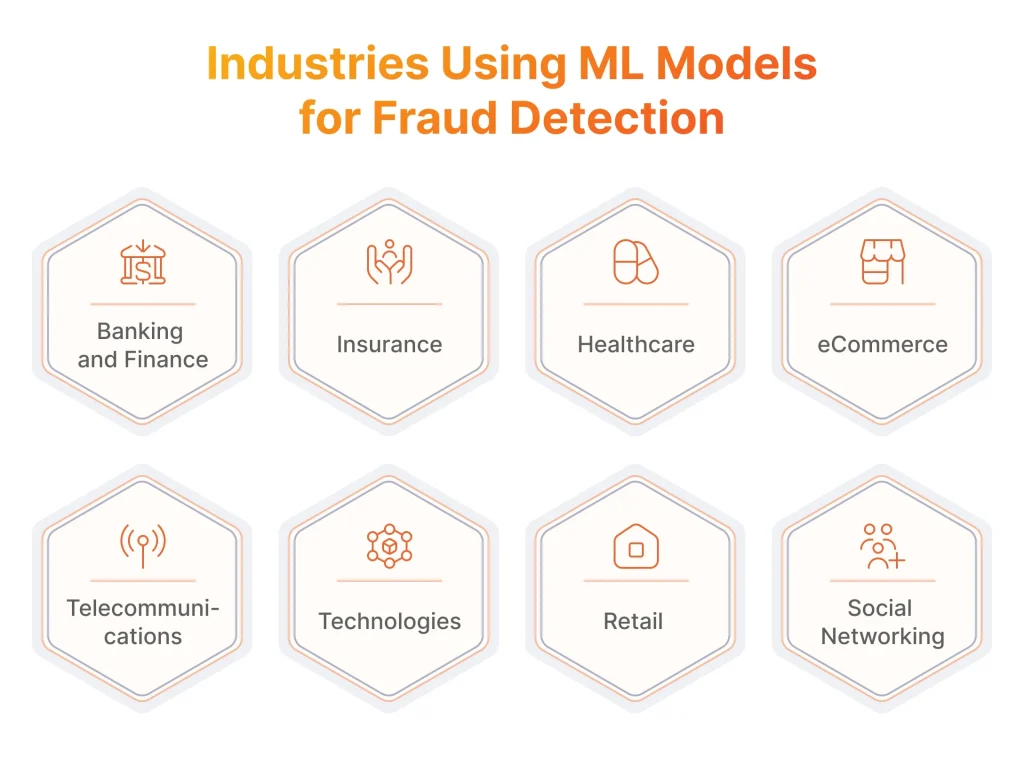
Banking and Finance
In banking and finance, machine learning plays a pivotal role in fortifying security measures, particularly for credit card fraud detection. By harnessing advanced ML algorithms and extensive datasets, banks and credit card companies utilize machine learning in the following ways:
- Transaction Monitoring: Models analyze real-time payment data, spotting unusual activity based on parameters like amount, location, and spending habits.
- Anomaly Detection: Algorithms identify irregularities in large datasets, such as unusually large transactions or unfamiliar locations.
- Pattern Recognition: Models learn from historical data to detect fraudulent patterns, using techniques like logistic regression and decision trees.
- Adaptive Learning: ML adapts to evolving fraud tactics, continuously updating detection strategies.
- Card-Not-Present Fraud Detection: Models analyze indicators like IP addresses and transaction velocity to detect online fraud.
Interested in learning more about machine learning in banking?
Dive into our comprehensive article for all the details!
Insurance
Insurance companies employ machine learning algorithms to analyze insurance claims data to protect themselves against financial losses due to fraudulent claims while ensuring fair and accurate claims processing for legitimate policyholders. A machine learning system helps insurance companies in the next way:
- Data Analysis: ML scrutinizes vast insurance claims data, including claim amounts, policyholder info, and accident details.
- Fraud Identification: Models like decision trees detect patterns of fraud, such as exaggerated claims or staged accidents.
- Pattern Recognition: Trained on historical data, ML models identify common fraudulent traits, like multiple claims or discrepancies in documentation.
- Real-time Detection: Machine learning algorithms operate in real-time, swiftly detecting potentially fraudulent claims as they are submitted.
- Enhanced Efficiency: Automation streamlines claim processing, reducing manual review time and costs while ensuring accurate reimbursement.
Healthcare
The applications of machine learning in healthcare helps to analyze medical billing data and detect fraudulent billing practices, such as upcoding, unbundling, and billing for unnecessary procedures. For healthcare, fraud detection using machine learning works as follows:
- Data Analysis: ML algorithms analyze medical billing data, including procedure codes, patient demographics, and billing amounts.
- Fraud Identification: Models like random forests and neural networks detect anomalies indicating fraudulent practices such as upcoding and unbundling.
- Anomaly Detection: Trained on data, ML models spot irregularities in billing patterns, enhancing accuracy in fraud detection.
- Real-time Monitoring: ML models operate in real-time, enabling them to detect potentially fraudulent billing practices and conduct prompt investigation and action.
eCommerce
eCommerce platforms and payment processors utilize machine learning models to analyze transaction data and detect fraudulent payment activities, such as stolen credit card information, account takeover, and payment redirection scams.
- Transaction Analysis: ML models meticulously examine payment data, including amounts, customer info, and history.
- Fraud Detection: Using sophisticated algorithms, models scrutinize data to identify fraudulent patterns like stolen card info, account takeovers, and payment scams.
- Stolen Credit Card Information: ML models detect transactions using stolen card data by analyzing purchasing behavior and address discrepancies.
- Account Takeover: Models identify unauthorized access attempts by analyzing login patterns, user behavior, and transaction history.
- Payment Redirection Scams: ML models detect and prevent payment redirection scams by analyzing transaction flows and payment details in real-time.
Telecommunications
In telecommunications, machine learning for fraud detection is essential to analyze network traffic data and detect fraudulent activities, such as toll fraud, call spoofing, and SIM card cloning. Here’s how it’s done:
- Data Analysis: A machine learning system analyzes telecom network data, including call records and user interactions.
- Fraud Identification: Using ML models, telecom companies detect toll fraud, call spoofing, and SIM card cloning through techniques like k-means clustering.
- Toll Fraud Detection: Machine learning detects abnormal calling patterns indicative of toll fraud attempts.
- Call Spoofing Detection: ML analyzes call metadata to identify spoofed caller IDs or unusual call routing.
- SIM Card Cloning Detection: Machine learning systems detect anomalies in network activity signaling potential SIM card cloning.
Technology
Fraud prevention with machine learning allows technology companies to conduct analysis of network logs, user behavior data, and system activity logs to detect cyberattacks, malware infections, and unauthorized access attempts in the following way:
- Data Analysis: ML models analyze diverse data sources like network logs, user behavior, and system activity for insights into network and user operations.
- Fraud Detection: Machine learning models use sophisticated algorithms to detect cyber threats such as cyberattacks, malware, and unauthorized access by analyzing data patterns.
- Anomaly Identification: Models like autoencoders, SVMs, and deep learning algorithms excel at identifying anomalies in real-time, including unusual network traffic or suspicious user behavior.
- Real-time Detection: Models operate in real-time, allowing technology companies to identify and respond to security breaches promptly by continuously monitoring network and system logs.
Retail
Machine learning and machine learning in retail to analyze transaction data, customer behavior, and inventory records. Machine learning algorithms detect various retail fraud types like return fraud, gift card fraud, and loyalty program abuse, utilizing advanced algorithms such as logistic regression and decision trees to identify suspicious patterns. Plus, predictive analytics in retail helps forecast the likelihood of return fraud by analyzing data on customer returns, purchase patterns, and product types.
- Payment Fraud Detection: Payment gateway integration services equipped with advanced ML models can provide instant alerts and automated responses to potential threats, minimizing financial losses and protecting both the bank and its clients.
- Return Fraud Detection: Machine learning analyzes payment data and customer behavior to spot return fraud indicators, like excessive returns or lack of receipts, while data analytical services allow forecasting potential return fraud based on historical transaction data.
- Gift Card Fraud Detection: Machine learning algorithms identify anomalies in gift card transactions, such as high-value purchases or unusual redemption patterns, indicative of fraud.
- Loyalty Program Abuse Detection: Machine learning scrutinizes loyalty program data to detect abnormal redemption patterns or suspicious account activities related to loyalty program abuse.
Social platforms use machine learning in fraud prevention systems to analyze user activity data, content engagement metrics, and account behavior patterns to detect fraudulent accounts, spam, and malicious activities.
- Data Analysis: Social platforms employ machine learning in fraud prevention to scrutinize vast user activity data, including likes, shares, comments, and interactions, extracting insights and spotting anomalies.
- Fraud Detection: ML models are pivotal in identifying diverse social media fraud types, leveraging advanced algorithms like semi-supervised learning and deep learning to detect suspicious behaviors.
- Suspicious Account Identification: By analyzing user activity and engagement metrics, ML models flag abnormal account behavior such as excessive posting or engagement with spam content.
- Prevention of Fake News: ML algorithms prevent fake news dissemination by analyzing content engagement metrics and flagging potentially misleading content for moderation.
- Social Media Manipulation Mitigation: ML models detect and mitigate social media manipulation tactics, enabling platforms to maintain the authenticity of user interactions.
How to Build and Set Up a Fraud Detection ML Model
It’s clear that every payment processing or payment gateway development company expects to gain from implementing machine learning in fraud detection solutions. If you’re prepared to combat financial fraud with ML models, it’s crucial to understand the steps in which the process unfolds.
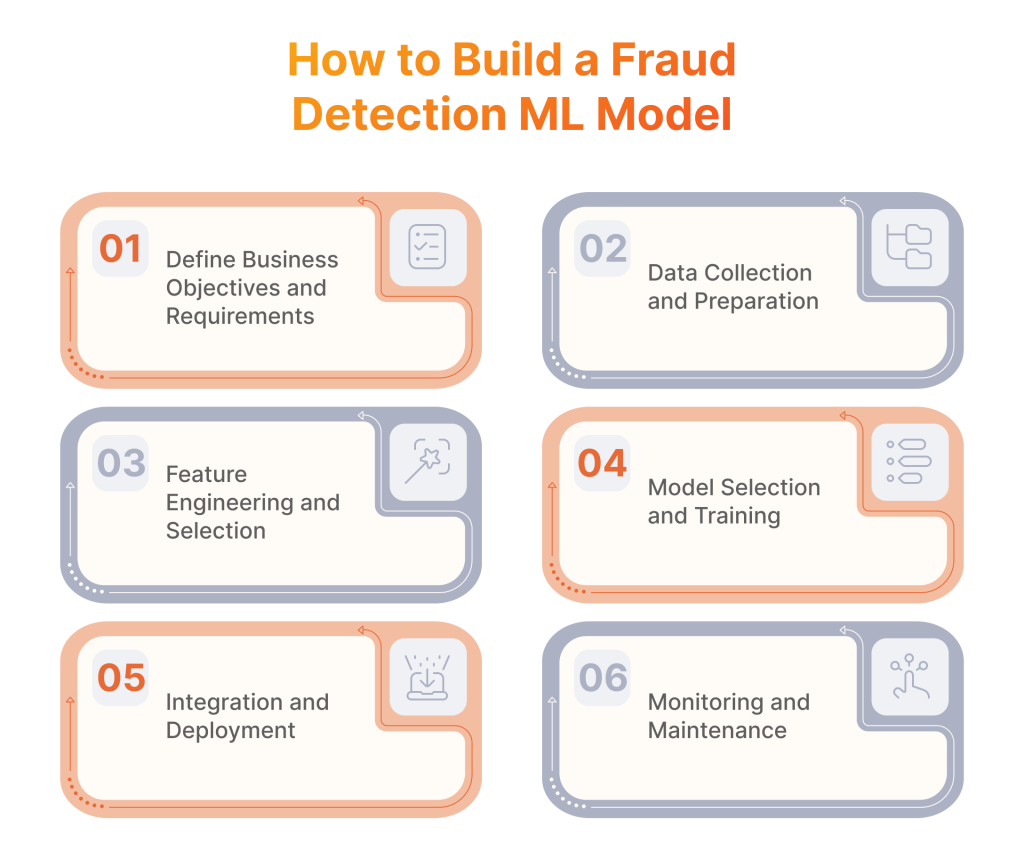
- Define Business Objectives, Metrics and Requirements: The foundation of any successful detection of fraud lies in a deep understanding of the unique fraud landscape of the business. By defining clear objectives, metrics and requirements, you pave the way for a targeted and effective strategy for detecting malicious practices.
- Data Collection and Preparation: Gather diverse and relevant new data sources, ranging from transaction logs and user profiles to behavioral patterns and historical fraud cases. Prepare this data meticulously to ensure its quality and suitability for training the fraud detection model.
- Feature Engineering and Selection: Transform raw data into meaningful features that capture the intricate patterns and behaviors indicative of fraud. Through advanced feature engineering techniques, extract actionable insights that empower your model to distinguish between legitimate and fraudulent activities effectively.
- Model Selection and Training: With a clear understanding of business requirements and feature-rich data at your disposal, select the right ML algorithms. Tailor your selection to match the unique characteristics of your data and the specific fraud challenges faced by your business. Train your chosen models rigorously to achieve optimal performance.
- Integration and Deployment: The true test of a fraud detection model lies in its seamless integration into the existing business ecosystem. Whether it’s payment gateways, transaction monitoring systems, or customer service platforms, ensure that your model integrates flawlessly to provide real-time detection capabilities.
- Monitoring and Maintenance: Implement robust monitoring mechanisms to track model performance in production. Continuously monitor key metrics such as detection rates, false positive rates, and model drift to ensure ongoing effectiveness. Regular maintenance and updates are crucial to maintain peak performance and prevent financial fraud.
Fraud Detection ML Model Development Challenges
While implementing a strong fraud detection mechanism is essential for the majority of financial, eCommerce and technology companies, there are some significant ML fraud detection model development challenges you should be aware of. Below are the most common ones.
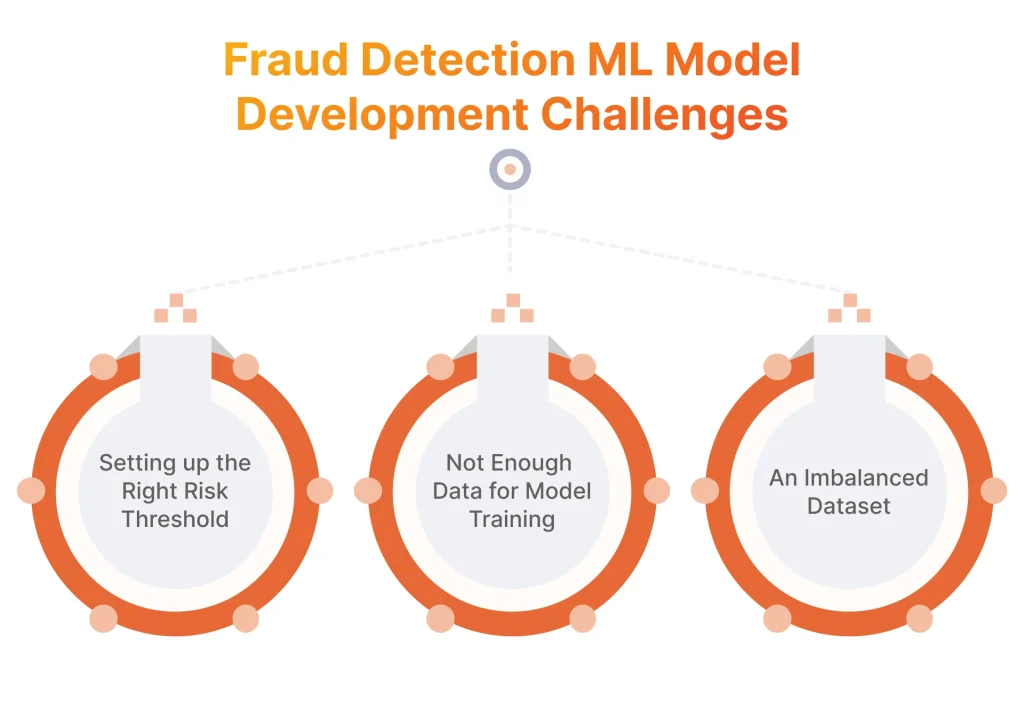
Setting up the Right Risk Threshold
One of the critical tasks of fraud detection systems is determining the appropriate risk threshold. This threshold acts as a safeguard, defining the level beyond which a transaction or event is flagged as fraudulent. However, finding the right balance between precision and recall is essential. Precision ensures that flagged cases are indeed fraudulent, while recall ensures that no fraudulent cases are missed. Striking this balance requires meticulous data analysis and fine-tuning of the risk threshold.
Having Not Enough Data to Train the Model
Data is the fuel that powers ML models. Because of the impact of big data, there is often a vast amount of data available, but ensuring that it is diverse, representative, and of high quality can still be challenging. This challenge becomes even more pronounced when dealing with specific use cases such as detection of fraud, where the data needs to capture rare and subtle patterns indicative of malicious activity.

Serhii Leleko
ML&AI Engineer at SPD Technology
“Strategies such as data augmentation, synthetic data generation, and collaboration with third-party data providers are commonly employed to address this challenge and enrich the training dataset, thereby improving the effectiveness of fraud detection algorithms.”
Having an Imbalanced Dataset
Imbalanced datasets, where the number of fraudulent cases is significantly lower than non-fraudulent ones, pose a significant challenge in detecting fraud. ML models trained on imbalanced datasets may exhibit bias towards the majority class, leading to poor performance in detecting fraudulent cases. Addressing this imbalance requires careful handling, such as classes weighting techniques, algorithmic adjustments, or the use of specialized loss functions that penalize misclassifications of minority classes.
Conclusion
Machine learning for fraud detection offers unparalleled advantages in identifying and mitigating malicious activities thanks to advanced algorithms and extensive datasets. Thus, businesses can effectively prevent different types of fraud, such as identity theft, account takeovers, phishing scams, and card-not-present fraud.
As a result, a fraud detection system powered by ML is widely utilized across industries including finance, eCommerce, insurance, healthcare, and retail to detect and prevent malicious activities. However, building and setting up a fraud detection system with ML models pose unique challenges, including defining appropriate risk thresholds, addressing data scarcity, and managing imbalanced datasets, which require careful consideration and expertise.
Despite these challenges, the transformative potential of machine learning in fraud detection is undeniable. By using ML, businesses can strengthen their defenses against fraudulent activities and safeguard their operations, finances, and reputation.
FAQ
What Type of Machine Learning Is Used in Fraud Detection?
Machine learning algorithms commonly used in fraud detection include supervised learning methods like logistic regression, decision trees, and ensemble methods, as well as unsupervised learning techniques such as k-clustering algorithms, isolation forests and autoencoders. Hybrid approaches, combining supervised and unsupervised learning, are also widely used.
How Does ML Detect Fraud on Bank Payments?
Machine learning for fraud detection on bank payments works by analyzing payment data, user behavior, and other relevant features. It looks for patterns or anomalies that deviate from normal behavior, indicating potential fraudulent activity. For example, ML models may flag transactions with unusual amounts, locations, or frequency as potential fraud and alert banking institutions for further investigation.
